Green-eyed Timothy Dalton (1944) is a British, classically trained Shakespearean actor who had successful careers in theatre, television and film. He is best known as James Bond in The Living Daylights (1987) and Licence to Kill (1989).
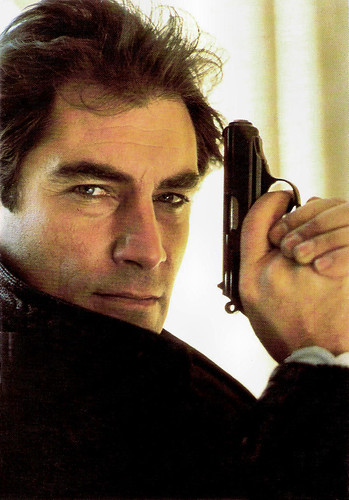
British postcard by Danjaq A.S. / United Artists, 1987. Photo: publicity still for The Living Daylights (John Glen, 1987).
The oldest of five children, Timothy Peter Dalton was born in Colwyn Bay, North Wales in 1944. He had an English father and an American mother of Italian and Irish descent. His father was stationed there during WWII but moved the family to Manchester in the late 1940s to work in advertising.
Timothy was fascinated with acting from a young age. After leaving Herbert Strutt Grammar School at the age of sixteen, he toured as a leading member of Michael Croft's National Youth Theatre. Between 1964 and 1966, he studied at The Royal Academy of Dramatic Art (RADA). Just before completing his two years, he quit and joined the Birmingham Repertory Theatre, playing the lead in many productions under the direction of Peter Dews while at the same time turning professional.
His talent and classic good looks immediately landed him professional work in television, guest-starring on an episode of the short-lived TV series, Judge Dee (1969), and as a regular on the 14-episode series Sat'day While Sunday (1967) with the young Malcolm McDowell. In late 1967, Peter O'Toole recommended him for the role of the young King Philip of France in the period drama The Lion in Winter (Anthony Harvey, 1968). The critically acclaimed film was a commercial success and won three Academy Awards.
The following year, he starred in the Italian film Giochi particolari/The Voyeur (Franco Indovina, 1970) with Marcello Mastroianni and Virna Lisi. Also during this time, he was approached and tested for the role of James Bond in On Her Majesty's Secret Service (1969) but turned it down, feeling he was too young for the part.
His next film was another costume drama, Cromwell (1970), working with director Ken Hughes, with whom he later made his first American film, Sextette (1978). He followed Cromwell with other period dramas like Wuthering Heights (Robert Fuest 1970) in which he portrayed Heathcliff, and Mary, Queen of Scots (Charles Jarrott, 1971) starring Vanessa Redgrave and Glenda Jackson.
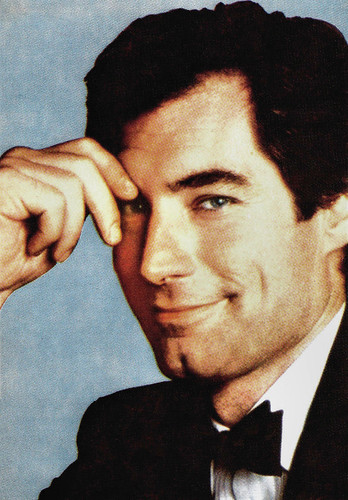
Romanian postcard by Casa Filmului Acin.
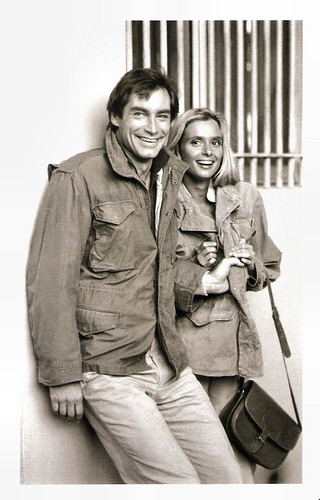
French postcard by Danjaq A.S. / United Artists, 1987. Photo: publicity still for The Living Daylights (John Glen, 1987) with Maryam d'Abo.
From the early to mid-1970s, Timothy Dalton decided to further hone his skills by going back into the theatre full-time. He signed on with the Royal Shakespeare Company (RSC) and the Prospect Theatre Company (PTC) and toured the world with both. In 1975, he returned to the cinema in the spy thriller Permission to Kill (Cyril Frankel, 1975) starring Dirk Bogarde. It was followed in 1976 by the Spanish religious historical film about the Inquisition, El hombre que supo amar/The Man Who Knew Love (Miguel Picazo, 1978), which was never widely released.
After this, he followed his first American film, the comedy/musical Sextette (Ken Hughes, 1978) as the husband of 85-year-old Mae West, and the American miniseries Centennial (1978), with Lynn Redgrave as his wife. After this, he began to get more frequent film and television work in the US, including the episode Fallen Angel of the TV series Charlie's Angels (1976).
In England, he starred on TV as Rochester in the BBC's very popular Jane Eyre (1983). Although most of his work until 1985 consisted of TV movies and miniseries, he did a few features. He played Vanessa Redgrave's husband in Agatha (Michael Apted, 1979), and Prince Barin in the campy Flash Gordon (Mike Hodges, 1980). Dalton followed this with a small film, Chanel Solitaire (George Kaczender, 1981) featuring Marie-France Pisier, and filmed a staged production of Antony and Cleopatra (1983) opposite Lynn Redgrave.
The years 1983-1987 were the most prolific of his career. The world was playing a guessing game as to who would succeed Roger Moore as James Bond. Dalton was approached but committed to the theatre, so Pierce Brosnan was offered the part. When Brosnan was unable to get out of his Remington Steele contract at the last minute, Dalton was again approached. Able now to work it into his tight schedule, he agreed. His first outing as Bond, The Living Daylights (John Glen, 1987), was critically successful and grossed more than the previous two Bond films with Roger Moore.
The second, Licence to Kill (John Glen, 1989), although almost as successful as its predecessor in most markets, did not perform as well at the US box office, in large part due to a lacklustre marketing campaign. Dalton's portrayal of Bond was darker and more serious than the light-hearted playboy of Roger Moore. Dalton's interpretation of Bond was obviously closer to the gritty realism of Ian Fleming's novels. In the mid-to-late 1980s, Dalton also narrated many nature documentaries. And he teamed with Vanessa Redgrave for a revival of The Taming of the Shrew (1988) and his interpretation of Petrucchio received uniformly high praise.
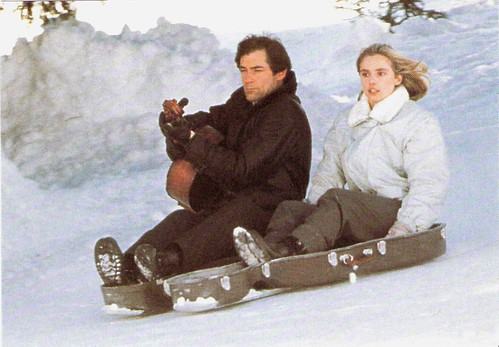
French postcard by Danjaq A.S. / United Artists, 1987. Photo: publicity still for The Living Daylights (John Glen, 1987) with Maryam d'Abo.
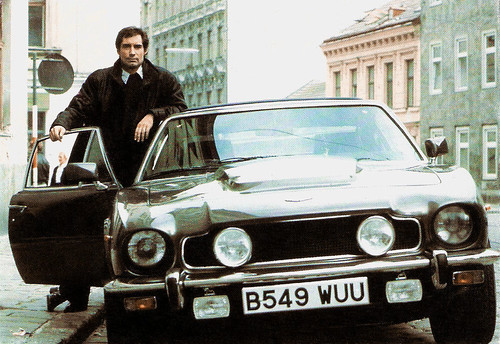
French postcard by Danjaq A.S. / United Artists, 1987. Photo: publicity still for The Living Daylights (John Glen, 1987).
Following Licence to Kill (1989), Timothy Dalton returned to one of his strengths, costume drama, in La putain du roi/The King's Whore (Axel Corti, 1990) with Valeria Golino. It was followed by his excellent performance in Disney's The Rocketeer (Joe Johnston, 1991), where he played a swashbuckling, Errol Flynn type.
In 1992, he starred in the TV mini-series Framed (Geoffrey Sax, 1992), which won a bronze medal at the 1993 New York Film Festival. In 1994, he took on the role of Rhett Butler in the eight-hour mini-series Scarlett (John Erman, 1994), an original sequel to Gone with the Wind (Victor Fleming, 1939). Scarlett, featuring Joanne Whalley, was a ratings success all over the world.
Dalton initially agreed to play James Bond for a third time in GoldenEye (Martin Campbell, 1995). Still, after a lengthy series of lawsuits between the studio and producers concerning the ownership of the character James Bond, and further script delays, he resigned from the role. He believed that too much time had passed since Licence to Kill (1989). The role went to Pierce Brosnan.
Dalton’s later films include the IRA drama The Informant (Jim McBride, 1997), The Reef (Robert Allan Ackerman, 1999), opposite Sela Ward, and the comedy The Beautician and the Beast (Ken Kwapis, 1997) co-starring Fran Drescher. He gleefully parodied his swashbuckling/James Bond image in Looney Tunes: Back in Action (Joe Dante, 2003) as a spy playing an actor playing a spy. Dalton was seen in The Tourist (2010) with Angelina Jolie and Johnny Depp. From 2014 to 2016, Dalton portrayed the character Sir Malcolm Murray for three seasons on the TV series Penny Dreadful. From 2019 to 2021, Dalton portrayed the Chief in the superhero series Doom Patrol.
Between 1980 and 1994, Timothy Dalton was the companion of Vanessa Redgrave. In 1995, Dalton began a relationship with Russian musician Oksana Grigorieva, with whom he has a son, Alexander (1997). They broke up around 2003.
Trailer Sextette (1978). Source: Movieclips Classic Trailers (YouTube).
Sources: Wikipedia and IMDb.
This post was last updated on 17 November 2023.

British postcard by Danjaq A.S. / United Artists, 1987. Photo: publicity still for The Living Daylights (John Glen, 1987).
Talent and classic good looks
The oldest of five children, Timothy Peter Dalton was born in Colwyn Bay, North Wales in 1944. He had an English father and an American mother of Italian and Irish descent. His father was stationed there during WWII but moved the family to Manchester in the late 1940s to work in advertising.
Timothy was fascinated with acting from a young age. After leaving Herbert Strutt Grammar School at the age of sixteen, he toured as a leading member of Michael Croft's National Youth Theatre. Between 1964 and 1966, he studied at The Royal Academy of Dramatic Art (RADA). Just before completing his two years, he quit and joined the Birmingham Repertory Theatre, playing the lead in many productions under the direction of Peter Dews while at the same time turning professional.
His talent and classic good looks immediately landed him professional work in television, guest-starring on an episode of the short-lived TV series, Judge Dee (1969), and as a regular on the 14-episode series Sat'day While Sunday (1967) with the young Malcolm McDowell. In late 1967, Peter O'Toole recommended him for the role of the young King Philip of France in the period drama The Lion in Winter (Anthony Harvey, 1968). The critically acclaimed film was a commercial success and won three Academy Awards.
The following year, he starred in the Italian film Giochi particolari/The Voyeur (Franco Indovina, 1970) with Marcello Mastroianni and Virna Lisi. Also during this time, he was approached and tested for the role of James Bond in On Her Majesty's Secret Service (1969) but turned it down, feeling he was too young for the part.
His next film was another costume drama, Cromwell (1970), working with director Ken Hughes, with whom he later made his first American film, Sextette (1978). He followed Cromwell with other period dramas like Wuthering Heights (Robert Fuest 1970) in which he portrayed Heathcliff, and Mary, Queen of Scots (Charles Jarrott, 1971) starring Vanessa Redgrave and Glenda Jackson.

Romanian postcard by Casa Filmului Acin.

French postcard by Danjaq A.S. / United Artists, 1987. Photo: publicity still for The Living Daylights (John Glen, 1987) with Maryam d'Abo.
A darker and more serious James Bond
From the early to mid-1970s, Timothy Dalton decided to further hone his skills by going back into the theatre full-time. He signed on with the Royal Shakespeare Company (RSC) and the Prospect Theatre Company (PTC) and toured the world with both. In 1975, he returned to the cinema in the spy thriller Permission to Kill (Cyril Frankel, 1975) starring Dirk Bogarde. It was followed in 1976 by the Spanish religious historical film about the Inquisition, El hombre que supo amar/The Man Who Knew Love (Miguel Picazo, 1978), which was never widely released.
After this, he followed his first American film, the comedy/musical Sextette (Ken Hughes, 1978) as the husband of 85-year-old Mae West, and the American miniseries Centennial (1978), with Lynn Redgrave as his wife. After this, he began to get more frequent film and television work in the US, including the episode Fallen Angel of the TV series Charlie's Angels (1976).
In England, he starred on TV as Rochester in the BBC's very popular Jane Eyre (1983). Although most of his work until 1985 consisted of TV movies and miniseries, he did a few features. He played Vanessa Redgrave's husband in Agatha (Michael Apted, 1979), and Prince Barin in the campy Flash Gordon (Mike Hodges, 1980). Dalton followed this with a small film, Chanel Solitaire (George Kaczender, 1981) featuring Marie-France Pisier, and filmed a staged production of Antony and Cleopatra (1983) opposite Lynn Redgrave.
The years 1983-1987 were the most prolific of his career. The world was playing a guessing game as to who would succeed Roger Moore as James Bond. Dalton was approached but committed to the theatre, so Pierce Brosnan was offered the part. When Brosnan was unable to get out of his Remington Steele contract at the last minute, Dalton was again approached. Able now to work it into his tight schedule, he agreed. His first outing as Bond, The Living Daylights (John Glen, 1987), was critically successful and grossed more than the previous two Bond films with Roger Moore.
The second, Licence to Kill (John Glen, 1989), although almost as successful as its predecessor in most markets, did not perform as well at the US box office, in large part due to a lacklustre marketing campaign. Dalton's portrayal of Bond was darker and more serious than the light-hearted playboy of Roger Moore. Dalton's interpretation of Bond was obviously closer to the gritty realism of Ian Fleming's novels. In the mid-to-late 1980s, Dalton also narrated many nature documentaries. And he teamed with Vanessa Redgrave for a revival of The Taming of the Shrew (1988) and his interpretation of Petrucchio received uniformly high praise.

French postcard by Danjaq A.S. / United Artists, 1987. Photo: publicity still for The Living Daylights (John Glen, 1987) with Maryam d'Abo.

French postcard by Danjaq A.S. / United Artists, 1987. Photo: publicity still for The Living Daylights (John Glen, 1987).
Rhett Butler
Following Licence to Kill (1989), Timothy Dalton returned to one of his strengths, costume drama, in La putain du roi/The King's Whore (Axel Corti, 1990) with Valeria Golino. It was followed by his excellent performance in Disney's The Rocketeer (Joe Johnston, 1991), where he played a swashbuckling, Errol Flynn type.
In 1992, he starred in the TV mini-series Framed (Geoffrey Sax, 1992), which won a bronze medal at the 1993 New York Film Festival. In 1994, he took on the role of Rhett Butler in the eight-hour mini-series Scarlett (John Erman, 1994), an original sequel to Gone with the Wind (Victor Fleming, 1939). Scarlett, featuring Joanne Whalley, was a ratings success all over the world.
Dalton initially agreed to play James Bond for a third time in GoldenEye (Martin Campbell, 1995). Still, after a lengthy series of lawsuits between the studio and producers concerning the ownership of the character James Bond, and further script delays, he resigned from the role. He believed that too much time had passed since Licence to Kill (1989). The role went to Pierce Brosnan.
Dalton’s later films include the IRA drama The Informant (Jim McBride, 1997), The Reef (Robert Allan Ackerman, 1999), opposite Sela Ward, and the comedy The Beautician and the Beast (Ken Kwapis, 1997) co-starring Fran Drescher. He gleefully parodied his swashbuckling/James Bond image in Looney Tunes: Back in Action (Joe Dante, 2003) as a spy playing an actor playing a spy. Dalton was seen in The Tourist (2010) with Angelina Jolie and Johnny Depp. From 2014 to 2016, Dalton portrayed the character Sir Malcolm Murray for three seasons on the TV series Penny Dreadful. From 2019 to 2021, Dalton portrayed the Chief in the superhero series Doom Patrol.
Between 1980 and 1994, Timothy Dalton was the companion of Vanessa Redgrave. In 1995, Dalton began a relationship with Russian musician Oksana Grigorieva, with whom he has a son, Alexander (1997). They broke up around 2003.
Trailer Sextette (1978). Source: Movieclips Classic Trailers (YouTube).
Sources: Wikipedia and IMDb.
This post was last updated on 17 November 2023.
No comments:
Post a Comment